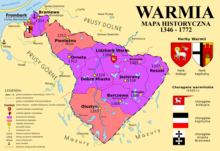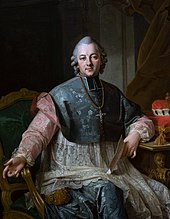Prince-Bishopric of Warmia
Prince-Bishopric of Warmia | |||||||||
|---|---|---|---|---|---|---|---|---|---|
| 1243–1772 | |||||||||
Banner used in the Battle of Grunwald (1410)
Original Coat of armsCoat of arms of the Prince-Bishopric of Warmia as a part of Poland
| |||||||||
Roman Catholic | |||||||||
| Government | Principality | ||||||||
• 1766–1772 | Ignacy Krasicki (last) | ||||||||
| Historical era | Prussian bishoprics
| 1243 | |||||||
• Gained imperial immediacy | 1356 | ||||||||
| 1464 | |||||||||
| 1466 | |||||||||
| 1479 | |||||||||
• First Partition of Poland: annexation and secularization by Prussia | 1772 | ||||||||
| |||||||||
| Today part of | Poland | ||||||||
The Prince-Bishopric of Warmia
It was founded as the Bishopric of Ermland
In 1440, most of the nobility and towns of Warmia joined the anti-Teutonic Prussian Confederation,[9] upon the request of which the region was incorporated into the Kingdom of Poland in 1454, and in 1464, during the following Thirteen Years' War, the Prince-Bishopric of Warmia sided with Poland and officially recognized the overlordship of the Polish King.[1] By the Second Peace of Thorn (1466) the Teutonic Knights renounced any claims to the prince-bishopric and recognized it as part of the Kingdom of Poland.[2] It since formed part of the newly constituted Polish province of Royal Prussia, and after 1569 along with the province joined the Polish–Lithuanian Commonwealth, within which it was part of the larger Greater Poland Province, and Warmia's autonomy gradually faded, however, it flourished as an important religious, scientific and cultural center in Poland, thanks to such figures as Nicolaus Copernicus, Stanislaus Hosius, Marcin Kromer and Ignacy Krasicki.
After the
By the Treaty of Warsaw (18 September 1773), King Frederick II guaranteed the free exercise of religion for the Catholics, so the religious body of the Roman Catholic diocese continued to exist, known since 1992 as the Roman Catholic Archdiocese of Warmia.
Within the State of the Teutonic Order

Along with
The Bishops of Warmia generally defended their privileges and tried to put down all attempts to cut the prerogatives and the autonomy the bishopric enjoyed.
After the Battle of Grunwald in 1410, the Sambian and Warmian bishops paid homage to King Władysław II Jagiełło of Poland and Lithuania, a maneuver to protect the territory from complete destruction.
Within the Kingdom of Poland
In February 1440 the nobility of Warmia and the town of Braunsberg (Braniewo) co-founded the Prussian Confederation, which opposed Teutonic rule, and most towns of the Prince-Bishopric joined the organization in May 1440.[9] In February 1454, the organization asked Polish King Casimir IV Jagiellon to incorporate the region to the Kingdom of Poland, to which the king agreed and signed the act of incorporation in Kraków on 6 March 1454,[12] and the Thirteen Years' War (1454–1466) broke out. During the war Warmia was recaptured by the Teutonic Knights, however, in 1464 Bishop Paul of Lengendorf sided with Poland and the Prince-Bishopric came again under the overlordship of the Polish King.[1]
In the

The bishops insisted on keeping their imperial privileges and ruled the territory as de facto
The Polish king accepted Tüngen as prince-bishop in the
Renowned Polish astronomer Nicolaus Copernicus lived in the prince-bishopric, in the towns of Lidzbark, Olsztyn and Frombork, and there he began and completed his groundbreaking work on heliocentrism. In 1521 Copernicus commanded the successful Polish defense of Olsztyn during a siege by the Teutonic Knights during the Polish–Teutonic War (1519–1521).[15]
The Diocese of Warmia lost the two thirds of its diocese within Teutonic Prussia after 1525 when the Order's Grand Master
Thus Bishop
After the
In this period the
Some churches were reconsecrated to or newly built for Catholic worship (e.g., St. Nicholas, Elbląg, Propsteikirche, Königsberg). Those new Catholic churches located in the ducal two thirds of Warmia diocese and in diocesan territory of the suppressed Samland see were then subordinated to the Warmian Frombork see. This development was recognised by the Holy See in 1617 by de jure extending Warmia's jurisdiction over Samland's former diocesan territory, only containing few immigrated Catholics. In practice the ducal government obstructed Catholic exercise in many ways.
Five Prince-Bishops of Warmia resigned from their position to become Archbishops of Gniezno and Primates of Poland, the highest representatives of the Catholic Church in Poland.

As a result of the First Partition of Poland in 1772, Warmia was annexed by the Kingdom of Prussia, and in 1773 incorporated into its newly formed province of East Prussia as bishopric of Ermland.
Aftermath
At the time of the break-up of the
The bishopric ceased to be an independent governmental unit, and King
Although the population of the bishopric Ermland remained largely Roman Catholic, religious schools were suppressed.[18] Although there had been schools teaching in the Lithuanian and Polish languages since the 16th century, those languages were forbidden in all schools in East Prussia by decree in 1873.
See also
Notes
- ^ a b c Górski 1949, p. LXXXII.
- ^ a b c Górski 1949, p. 99, 217.
- ISBN 978-0-8006-7085-6.
- ^ Biskupie Księstwo Warmińskie @ Google books
- ^ Fürstbistum Ermland @ Google books
- ISBN 978-0-521-85332-3.
- ^ a b Górski 1949, p. 96-97, 214-215.
- ^ Ermland, or Ermeland (Varmiensis, Warmia) a district of East Prussia and an exempt bishopric (1512/1566–1930), Catholic Encyclopedia, [1]
- ^ a b Górski 1949, p. XXXI, XXXVII.
- ^ Herbermann, Charles George; Pace, Edward Aloysius; Pallen, Condé Bénoist; Shahan, Thomas Joseph; Wynne, John Joseph (1913). "The Catholic Encyclopedia: An International Work of Reference on the Constitution, Doctrine, Discipline, and History of the Catholic Church". The Catholic Encyclopedia.
- ^ Max Töppen's Historisch-comparative Geographie von Preussen
- ^ Górski 1949, p. 54.
- ^ Zarządzenie Prezydenta Rzeczypospolitej Polskiej z dnia 8 września 1994 r. w sprawie uznania za pomnik historii., Dz. U. z 1994 r. Nr 50, poz. 414
- ^ Rozporządzenie Prezydenta Rzeczypospolitej Polskiej z dnia 20 kwietnia 2018 r. w sprawie uznania za pomnik historii "Lidzbark Warmiński - zamek biskupów warmińskich"., Dz. U. z 2018 r. poz. 944
- ^ Jerzy Jan Lerski, Piotr Wróbel, Richard J. Kozicki, Historical dictionary of Poland, 966-1945, Greenwood Publishing Group, 1996, p. 403
- ^ a b Albertas Juška, Mažosios Lietuvos Bažnyčia XVI-XX amžiuje, Klaipėda: 1997, pp. 742-771, here after the German translation Die Kirche in Klein Litauen Archived 2013-03-09 at the Wayback Machine (section: 2. Reformatorische Anfänge; (in German)) on: Lietuvos Evangelikų Liuteronų Bažnyčia Archived 2011-10-02 at the Wayback Machine, retrieved on 28 August 2011.
- ^ "Olsztyn: najstarsze seminarium duchowne w Polsce skończyło 450 lat". wPolityce.pl (in Polish). Retrieved 9 August 2020.
- ^ Catholic Encyclopedia
References
- history of Warmia in German Wikipedia
- The Catholic Encyclopedia, Vol 3 - History of Bischopric of Ermsland.
- Warmia and Mazuria History library- in Polish
- Bistum Ermland. Detailed legal exempt status, with Teutonic Order as protector, then Polish king as protector(protectio) not (superioritas) book in German
Bibliography
- Górski, Karol (1949). Związek Pruski i poddanie się Prus Polsce: zbiór tekstów źródłowych (in Polish and Latin). Poznań: Instytut Zachodni.



